Today’s walk to the East End was a new and different experience for me. Having grown up in a middle class, white, rural area it was wonderful to actually see the complete opposite of the area in which I grew up. As much as I love ethnic street fairs and pan-asian food I had never really seen an area so completely different from the one I am used to.
When I read Salaam, Brick Lane I had problems envisioning the actual street. As much as I enjoyed the book I still was picturing more of a slum than a habitable living area (Jack London’s quotes about murder and refuse didn’t help). Indeed, when the book was written things were much worse in that area than they are now, but it was still quite helpful for me to actually see the setting.
What struck me most was that even though the Gherkin could still be seen over the tops of the buildings, it actually felt like we were in a completely different city. Sadly most of the shops were closed due to Ramadan, but it is definitely a place I want to explore further.
However, it was surprising to see just how much it had changed since Mr. Hall wrote his book. From what he described I assumed Brick Lane to be little more than a slum. While not exactly the nicest neighborhood it was far from unpleasant. From the number of people in their mid-twenties that I saw wandering around it seems as though the area is an up-and-coming place. This is just another example of the ever changing demographic in this section of London. Instead of a new group of immigrants it seems to me that perhaps the next tenants will be young adults looking for their first apartment. From what I saw today I wouldn’t mind living there myself.
In contrast, this afternoon we took a tour of St. Paul’s Cathedral. It was quite a stark difference going from the rather poorer East End to the opulence of Christopher Wren’s masterpiece. While the entire tour was interesting, the highlight was definitely the trek up the dome. The view from the top was breathtaking. We were treated to a view of the whole of London spread out beneath us, and as segregated as parts of London are on the ground, from up that high there are no boundaries drawn between sections of the city. It is all just one big sprawling mass and there are no distinctions. It was a nice change from the racism we have been discussing during class.
It was a good day and I’d love to explore the East End further.
Tags: Campbell
September 2nd, 2009 · 1 Comment
Author’s Note: This post was written and live by yesterday at 2:45 PM. Due to systems maintenance back at Dickinson where the servers are, it was mysteriously deleted and all traces ceased to exist on the Internet. Fortunately I managed to find a partial backup of the post with Firefox’s super clutch about:cache utility. Panic attack over.
Okay, so I was the only one who opted out of going to the backstage tour of the National Theatre. Bad call Andrew, bad call. So while I depressively sit in my room waiting for the group to return, I might as well write one big über-post reflecting on the last week or so here in Britain.
To go back a few days, after Stonehenge, we schlepped out to Bath. I experienced some major mixed fellings on the way there. A knowledgeable friend told me that if there is one place to see in the UK, it is Bath. However, it’s a city whose economy is completely reliant on tourism, and I hate tourist traps. The city itself is a sight to be seen. The architecture stands out most clearly, as almost every building within the city limits is built in the Georgian style of the 18th and 19th Centuries.

http://en.wikipedia.org/wiki/Bath,_Somerset
The first landmark we encountered was Bath Abbey, a picturesque Gothic cathedral from the 7th Century. I stood outside and stared at the exterior for a good ten minutes before entering. It is enchanting, imposing, captivating, and just about any other adjective of the sore fathomable. With that in mind, I was thrilled to go inside. The interior was the mixed feelings I had earlier incarnate. The nave itself is gorgeous, featuring high, vaulted ceilings and intricate stained glass windows reminiscent of Westminster. Juxtaposing the ancient architecture, however, were LCD monitors, postcard stands, and any other touristy accoutrement you can imagine. That made me physically sick to the stomach. It is one thing to have a gift shop attached to historical sites, as long as they are distinctly separated. There is nothing wrong with a tourism economy. But just as the Church and the State should be mutually exclusive, so should the site and the shop. A message to the tourism bureau of Bath: NEVER SHIT WHERE YOU EAT. It is not only offensive to the historical purity of the building, but downright sacrilegious to so blatantly mix shopping with as place as important as Bath abbey.
On a related note, The Tower of London wasn’t any better. Maybe we just chose the worst possible time to visit, but it was absolutely stuffed to the gills with sightseers. We forewent seeing the illustrious crown jewels because the queue was longer than the line for Splash Mountain in Disney World. And I’m sure the main attraction isn’t nearly as exciting. To be entirely honest, I didn’t learn much during my time at the Tower. I know that it is very rich historically, serving as a fortress, a prison, a headquarters, and most recently, a kitschy tourist trap. The most best aspect were the enormous ravens hanging out all over the grounds. They made entertaining noises. Not worth the money. (I took the following photographs.)


CAWWW!
Phew. Ranting is cathartic.
Also, I am attempting to embed a slideshow of Bath Abbey into this post, but am failing miserably. I am giving up and posting a link to a slide.com slideshow instead. Click here to view.
Moving on, yesterday was the world famous Notting Hill Carnival, the second largest street festival on the planet. To give the reader a perspective, imagine a crowded rock concert, complete with all the four essential, ubiquitous smells: food, beer, body odor, and ganja. Now take that crowd and spread it out over a twenty square mile radius, but don’t bother thinning out the population density. This year’s attendance figures aren’t live yet, but in past years the event has attracted an upwards of 1.5 million people split over two days, most on Monday, the main event. Since everything else is closed due to the national bank holiday, about an eighth of London’s population has nothing better to do, so why not get a taste of Afro-Caribbean culture and go to Carnival? (When reading, make sure to roll the R in Carnival for dramatic effect). Everywhere I went was in earshot of calypso, reggae, soca, or any other Caribbean-centric music played at rock concert decibel levels. There were more jerk chicken booths than Starbucks in Manhattan. Red Stripe and Corona quenched the throats of everyone, from the lavishly dressed parade people to the pasty white 20-somethings who can’t dance, in attendance just to escape the vanilla routine of Western life (i.e. me). It is definitely worth seeing, but make sure you arrive in the afternoon. We made the mistake of getting there at 10 AM, and were bored for about two hours.
Slideshow attempt #2
On a completely unrelated note, I have been listening to a lot of jazz lately, namely good hard-bop from the early 70s. I listen to a lot of music and it is by far one of my favorite genres, especially when seen live. As a result, I’ve been craving some raw, live jazz, and what better place to experience it than in the cultural center of the UK. I’ve also been considering writing my research paper on the London jazz scene, so it’s probably a good idea to get out there and experience it first hand. My rabid Googling has pointed me to a place called the 606 Club (click the link to see where the club got it’s name). The reviews are pretty glamorous (“London’s best music venue”), so I’m very excited to go in for a cocktail and listen to some great improvisational jazz, or whatever they have playing that evening. If you have never seen good jazz played in person, trust me on this one and come along to see the show. It is truly the best kind of live music around. Skilled musicians can emanate such powerful emotion from their horns, basses, drums, or voices unheard of in rock, hip-hop, or anything else kids today listen to. Definitely worth the £10 or so cover.
That about does it for now. I’m gonna get back to drinking wine alone in my underwear.
Tags: Andrew B
When I was first told about the Notting Hill Carnival, I have to say I was quite excited about getting the opportunity to attend. However, I really had no idea what to expect. I was told it was the second biggest street festival in Europe, so naturally I thought it would be intense. When we arrived in the morning it seemed pretty dead. The rubbish in the streets told me the prior day must have been quite a good time. I am glad that one of my first discoveries was a 2 litre bottle of Strongbow cider; something I did not expect to see at all. Nonetheless, my initial reaction was one of disappointment. We just walked about looking for a place to sit in order to watch the inevitable parades.
Despite the disappointing morning, the carnival came to life as noon approached. The first thing we saw was a very diverse parade. The participants ranged from a person dressed in what appeared to be a wedding dress with attached skeletons and machine guns to dinosaurs, a snake/bird creature and Corona girls. It appeared like everyone was having a good time, but I was still expecting more people. Luckily, the crowds did begin to grow once we started walking around the neighborhood.
One aspect of the carnival which really interested me was the political graffiti. It seemed that almost all of it, from what I saw, was “leftist” in nature. Two in particular caught my eye. One was a banner of sorts with Che Guevara in the middle. Spray painted on the red background was “Who the f*ck is this” with the response “Surely not Che?” I thought this was very interesting and entertaining. The other piece of graffiti I enjoyed was just a quote spray painted on wood which said “In a democracy dissent is an act of faith.” Overall, I am glad I was able to spot the graffiti I did see and be able to capture it through a lens before it was washed away.
-
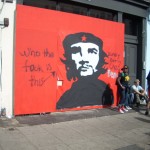
-
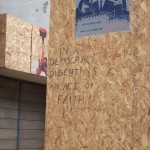
In the end, I really liked what I saw of the carnival. The food was simply amazing and very numerous. It was hard not to walk five feet and not spell something delicious being cooked. The parades were also fun to watch, especially the Jamaican one. Nevertheless, I still did expect more people. Though the crowds were pretty big, for the second largest street festival in Europe, I was disappointed at the amount of people. Of course, that does not mean I would not come back because it was an amazing experience and one I do not regret.
Tags: Andrew F
September 2nd, 2009 · 3 Comments
I’m not one for long, verbose titles; I prefer to let my artwork (if a blog post could be considered such) stand on its own. I suppose that’s why The British Museum and The National Gallery appealed to me, because these museums are arranged in such a way that the art and artifacts are privileged over their context and allowed to speak for themselves. Information is available at both museums for those who want to learn more about an individual piece, but signage is simple and audioguides are discreet.
I devoted most of my time spent at The National Gallery to the 18th-20th centuries exhibit, which featured works by Monet, Manet, Picasso, van Gogh and Degas. The piece which affected me most viscerally was Vincert van Gogh’s “Sunflowers,” a painting which I had seen many times on postcards, coasters, prints hanging on water-damaged walls or in the only remains of my mother’s abandoned art degree – in her art books. Seeing this work in person was an incredible experience. Having the opportunity to experience the thoughts, emotions and perceptions of one of the world’s most renown artists though one of the world’s most renown pieces of artwork affected me very deeply. What struck me about works in both museums, but “Sunflowers” in particular, was the work’s enduring relevance diachronically. Though styles and historical contexts are particular to a piece of art and remain fixed, its meaning is mutable. This, I feel, is the true beauty of art.
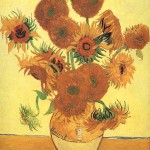
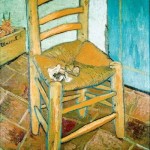

At The British Museum, I had a similar reaction to seeing and touching part of a column which came from the Parthenon. It is amazing how these artifacts have managed to remain in tact and meaningful for thousands of years. One sign that caught my attention was one which told the story of how Lord Elgin brought pieces of the Parthenon back to England in 1806. The signage, as well as other historians and archaeologists, claims that Elgin essentially saved the artifacts from further destruction and preserved them by bringing them to England. However, now that Greece has the means to afford an appropriate Acropolis Museum, there is much debate regarding the British Museum’s collection of artifacts, uncluding a number of friezes.
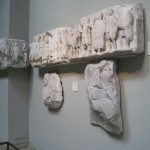
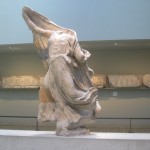
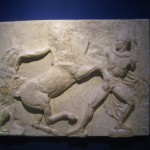
Both The National Gallery and The British Museum seem to honor artwork and artifacts over their historical context. Though considering where these pieces came from is crucial in understanding their meaning, perhaps where they are going, such as the friezes and sections of column of the Parthenon, and their relevance to our culture in the present and future is what should be more important.
Tags: Anya · Museums











